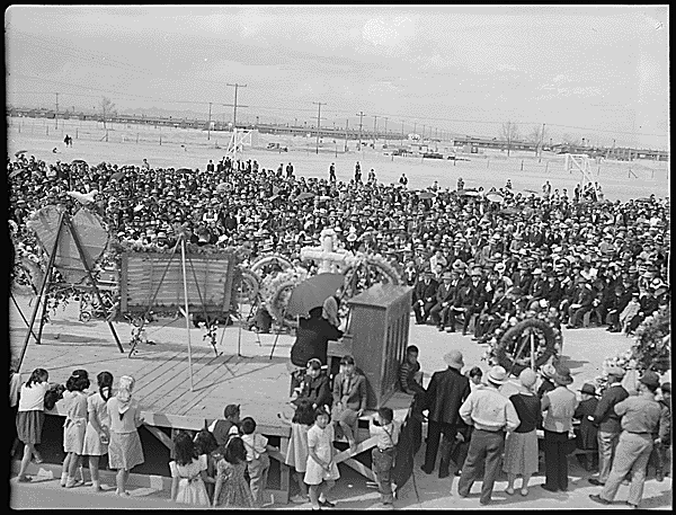WWII & Japanese American Incarceration
EXTRA EXTRA: US AT WAR!
On Sunday morning, December 7, 1941, Japanese bombs fell on Pearl Harbor, a naval base and the headquarters of the U.S. Pacific Fleet in Honolulu. In a matter of minutes, more than 2,400 lost their lives.
At the time of the Pearl Harbor attack, World War II was already raging in Europe and other parts of the world. Germany, led by Adolf Hitler, had invaded Poland in 1939, triggering the start of the war in Europe. Over the next few years, Germany had conquered much of Europe, and the Axis Powers, including Italy and Japan, were aligned against the Allies: the United Kingdom, Soviet Union, and later, the United States.
The US had initially adopted a policy of neutrality in the conflict, focusing on aiding the Allies through economic and military support without direct involvement. However, the surprise attack prompted the U.S. to abandon its isolationist stance. The following day, December 8, 1941, President Franklin D. Roosevelt delivered his famous "Day of Infamy" speech, urging Congress to declare war on Japan.
I was 14 years old, and with my girlfriends Marty and Seiko had gone to the movies that fateful Sunday. The film was interrupted and an announcement made for all servicemen to return immediately to their bases. On the way home we saw the headlines in the Oakland Tribune, with four-inch letters screaming “JAPS BOMB PEARL HARBOR!” We were frightened and ran home.
—Daisy Uyeda-Satoda
Roosevelt delivering the “Day of Infamy” speech, December 1941. Public Domain
Japanese Americans had long been targets of suspicion and hostility in San Francisco; there were strong sentiments that the Japanese weren’t “really” American, rumors that their children were secretly taught to revere the Japanese emperor, not the US Constitution. After Pearl Harbor, white people began to drive through Nihonmachi, staring at residents. The authorities began ransacking homes, looking for incriminating materials, and arresting “suspicious” Japanese, including Daisy Uyeda’s father:
A few months later, several FBI agents came to our house and arrested my father. My mother had already packed a change of clothing and a toilet kit, since leaders of Japanese American communities all over the West Coast were being rounded up and imprisoned. The younger children threw their arms around Papa’s legs and begged the agents not to take their father away. They took him away in handcuffs. That was one of the saddest days of our lives. The next day, the Oakland Tribune article read that a Mitsuzo Uyeda, leader of the Military Virtue Society of Japan, had been taken into custody (there never was such an organization).
—Daisy Uyeda-Satoda
With the United States at war, Japanese Americans took drastic measures to distance themselves from any signs of allegiance to Japan—burying Japanese flags, destroying Japanese-language books and letters sent from relatives. Despite these measures, all people of Japanese descent, regardless of their citizenship status, were soon designated “enemy aliens.”
9066
In February 1942, President Roosevelt signed Executive Order 9066, expelling “all persons of Japanese ancestry, including aliens and non-aliens,” from West Coast military zones. Every Japanese person in San Francisco was ordered to report at various sites.
In Spring 1942, the Army began the systematic removal of Japanese and Japanese Americans from the entire West Coast into camps in the US interior. Once a “Civilian Exclusion Orders” was posted throughout Nihonmachi, Japanese Americans were given one week in which to register with the authorities, gather whatever possessions they could carry, and report to a civilian control center.
Homeowners sold their houses, and business owners their farms, stores, and restaurants, hurriedly and at steep discounts, often for pennies on the dollar.
In the last days of April, 1942, residents of Nihonmachi lined up at Kinmon Gakuen, which the Army had commandeered to use as a Civilian Control Center. Stripped of their belongings except for what they could carry, they were bussed 12 miles to Tanforan Racetrack in San Bruno. Overnight, Nihonmachi’s 5,000 Japanese and Japanese Americans were gone, leaving behind a ghost-like lacunae of empty apartments and businesses.
Courtesy of the National Archives and Records Administration.
Tanforan was a temporary holding area, where we joined about 8,000 other Japanese from the San Francisco Bay Area for the next four months. Our family was fortunate in that we were assigned to live in tarpapered barracks rather than the filthy, manure-laden horse stables. There was no furniture, save for 12 metal cots. We were given cotton bags and sent to a straw pile to fill up these bags which were to be our mattresses.
We were fed in a huge room under the grandstands. Food was ladled out from galvanized tubs. It was horrible and most of us had dysentery for much of the time we were in Tanforan. The cooks were fellow inmates and most of them had no cooking experience, especially with American cuisine.
The most humiliating experience shared by most females was the lack of privacy in the bathrooms. Toilet seats were all in a row and back-to-back. Shower stalls had no curtains. Everything was communal. We spent half of our time waiting in lines – to eat in the mess halls, to go to the bathroom, to take a bath, to wash our clothes, and for twice daily head counts.
—Daisy Uyeda-Satoda
Residents of Nihonmachi waving goodbye to a round of busses leaving for Tanforan in San Bruno. Credit: Dorothea Lange, WPA, Public Domain
The assembly centers like Tanforan were converted racetracks and fairgrounds, where thousands of people slept in stables, livestock stalls, or the open air for months. From Tanforan, most of San Francisco’s Japanese residents – including Daisy and her family – were sent to the Topaz internment camp in Utah, one of 10 hastily built “relocation” camps scattered across the barren stretches of the country.
The “Jewel of the Desert”
The sites of the camps—Topaz in Utah, Minidoka in Idaho, Gila River and Poston in Arizona, Heart Mountain in Wyoming, Amache in Colorado, Rohwer and Jerome in Arkansas, and Tule Lake and Manzanar in California—had been chosen for their remote locations in dry deserts and barren hillsides. When they reached the incarceration camps, they were met with spartan, prison-like compounds, with armed guards and watchtowers looming over barbed-wire enclosures. Families were often housed in cramped and hastily constructed barracks, lacking privacy and basic amenities. The living conditions were unsanitary, with communal bathrooms and limited access to clean water. The internees had limited medical care, and makeshift schools – like Topaz High, which Daisy attended for three full years — offered subpar education as most faculty lacked any teaching credentials.
Life in the camps had a prison-like flavor of intense scrutiny: armed guards, barbed wire fences, and watchtowers reinforced the feeling of being treated as enemy combatants.
Despite the rough circumstances, life in the camps began to follow a routine as internees still attempted to create a sense of community and normalcy. Students like Daisy went to school every day, where she and her classmates took up leadership positions and participated in sports, plays, yearbook club, and the school newspaper. Adults worked different jobs and set up community institutions like newspapers, businesses, sports teams, concerts, places of worship.
Topaz Aerial photo, public domain
Swing Band practice at Heart Mountain incarceration camp. September 16, 194 Courtesy of California State University, Fresno.
However, life in internment also eroded some important tenets of the Japanese American community: traditional Japanese family structure emphasizes close nuclear households and respect for elders, which was undermined by mess halls where young people ate meals with friends rather than parents. Paying jobs were only given to U.S. citizens—i.e., the younger generation who, as the new breadwinners, took on new leadership roles while the Issei, who had worked for decades to create livelihoods in the U.S. and lead their families, were sidelined.
On April 11, 1943 James Hatsuaki Wakasa was shot by a Topaz watchguard. The guard later testified that he meant for the shot to be a warning. He was charged with manslaughter but later acquitted. Mr. Wakasa was five feet within the fence when he was killed. An autopsy found he was facing the guard when he was shot.
James Wakasa’s funeral, Courtesy of the National Archives and Records Administration.
Loyalty?
After Pearl Harbor, the U.S. administered a series of questionnaires to assess the loyalty and willingness of Japanese Americans to serve in the U.S. military and swear allegiance to the United States, even as they were being incarcerated in the camps.
The loyalty questionnaires were a source of controversy and confusion. Some of the questions were perceived as tricks or as unfairly singling out Japanese Americans. Two were particularly infamous:
Question 27 asked whether individuals would be willing to serve in the U.S. armed forces and swear unqualified allegiance to the United States.
Question 28 asked whether individuals would foreswear any form of allegiance or obedience to the Japanese emperor, even if directed to do so.
Responding with a "no" to either of these questions was considered a refusal to pledge allegiance to the United States, and those who did so were labeled "No-No Boys." These individuals were often subjected to further scrutiny, suspicion, and sometimes even segregation within the internment camps.
The motivations behind the "No-No Boys" varied. Some refused to comply as an act of protest against their unjust incarceration and the violation of their civil rights. Others were influenced by a complex mix of factors, including fear, confusion, cultural loyalty, and distrust of a government that had unjustly targeted them.
In April 1943, the government began administering a controversial loyalty exam to the Japanese Americans incarcerated at Topaz. Courtesy of the Utah State Historical Society
Throughout the war, many Japanese Americans also protested their treatment by insisting that they be recognized as loyal Americans. Some enlisted in the armed forces. While early in the war they had been barred from military service, by 1943 the army was actively recruiting Nisei to join new all-Japanese American units. More than 30,000 men served. The famous 442nd Regimental Combat Team became the most decorated unit of its size in U.S. history, receiving more than 18,000 individual decorations, including 52 Distinguished Service Crosses and one Congressional Medal of Honor.
Want to Learn More?
"The Ghosts of No-No Boy in a Nation That Still Imprisons Immigrants," The Margins, Asian American Writers Workshop, 2020.
A short film about Joy Takeshita Teraoka, singer for the George Igawa Orchestra, the jazz band which formed at Heart Mountain during WWII and performed in camp and across Wyoming, 2019
“Surviving Democracy's ‘Mistake’: Japanese Americans & the Enduring Legacy of Executive Order 9066”
Jewel of the Desert, by Sandra Taylor
Whispered Silences: Japanese Americans and World War II, by Gary Y. Okihiro
Daisy’s full testimony: https://www.nps.gov/articles/000/daisy-uyeda-satoda.htm
Campu Episode Three: Fences








